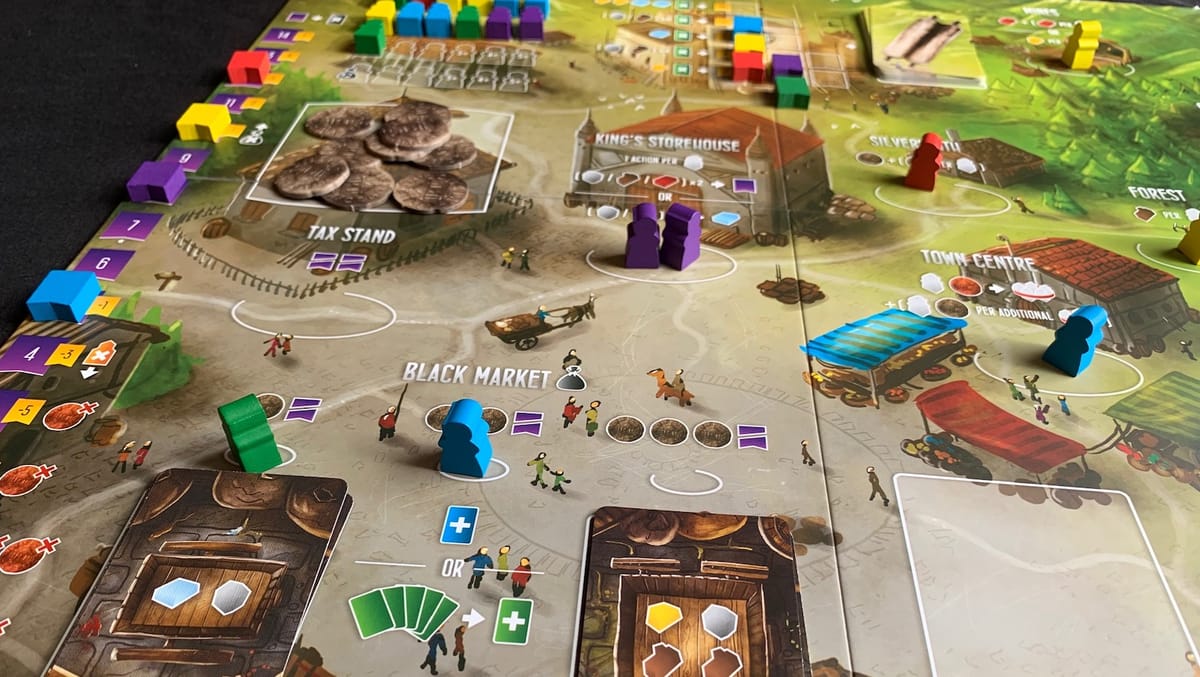
It’s 850 AD, and the king wishes to build his kingdom as quickly as possible, and by any means necessary. He employs you and other eager architects of the west kingdom to get the job done. He cares not for what you must do to undercut each other, he just wants the job done and will reward the person who does it best.
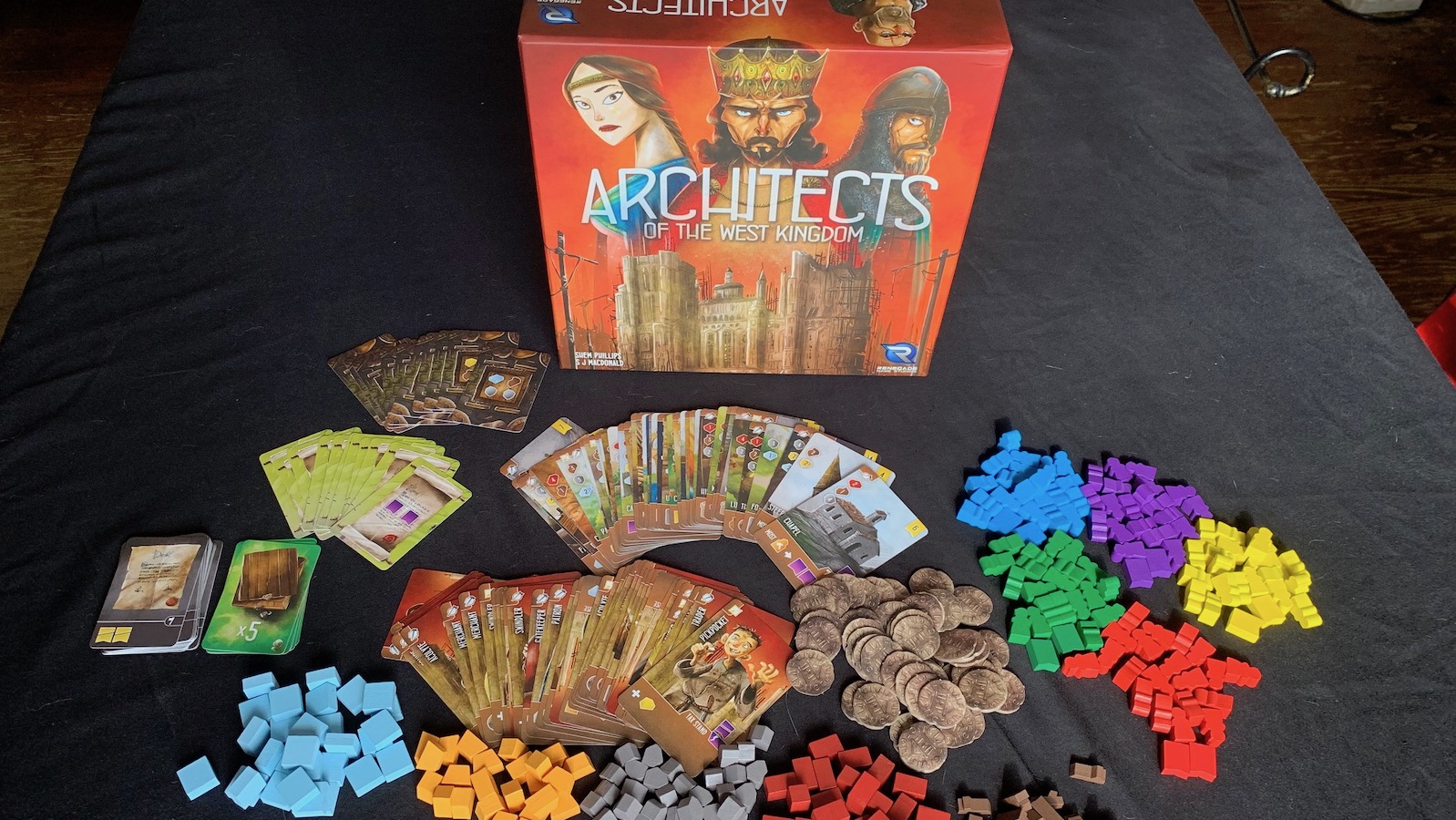
Architects of the West Kingdom is a 1-5 player game by Garphill games. Fans of the company will recognize the artwork and game design immediately, and it will remind them of their past games in the Raiders of the North Sea series. Both are worker placement games set in times past with many many spots to send your workers, and helper cards to aid you in your task, but from there, the similarities cease.
The designers of Architects seem to have set out with the idea of changing the worker placement game as we know it in mind. For the most part in the worker placement genre, players will take turns playing a single worker in a space with enough room for only his or her worker. The space in which they place their piece grants them a certain action, and they take it. Once everyone has placed all their workers, everyone collects them back from the board and starts the next round of play.
In Architects, while players still take turns placing workers and taking actions, most of the spaces are large, and can hold as many workers as players want to send there. The more workers present at a space, the more return the player gets out of that action. The main goal of the game is to build the most buildings in the kingdom, and receive the most Victory Points for doing so. The board is divided up in to 11 spaces. 4 of them let the players gather resources they will need to build. The Quarry get the players stone, the Forest gives wood, the Mine gives clay or gold, and the Silver Smith gives silver coins, the currency in the game. The first time a worker is sent to any of these spaces a small amount of these resources is returned, but every time a worker is placed there after that, the return multiplies. Other spaces such as the Guardhouse and the King’s Storehouse have a few different options as to the actions taken when a worker is placed there. As more workers show up, the player is able to take more of those actions in a single turn.
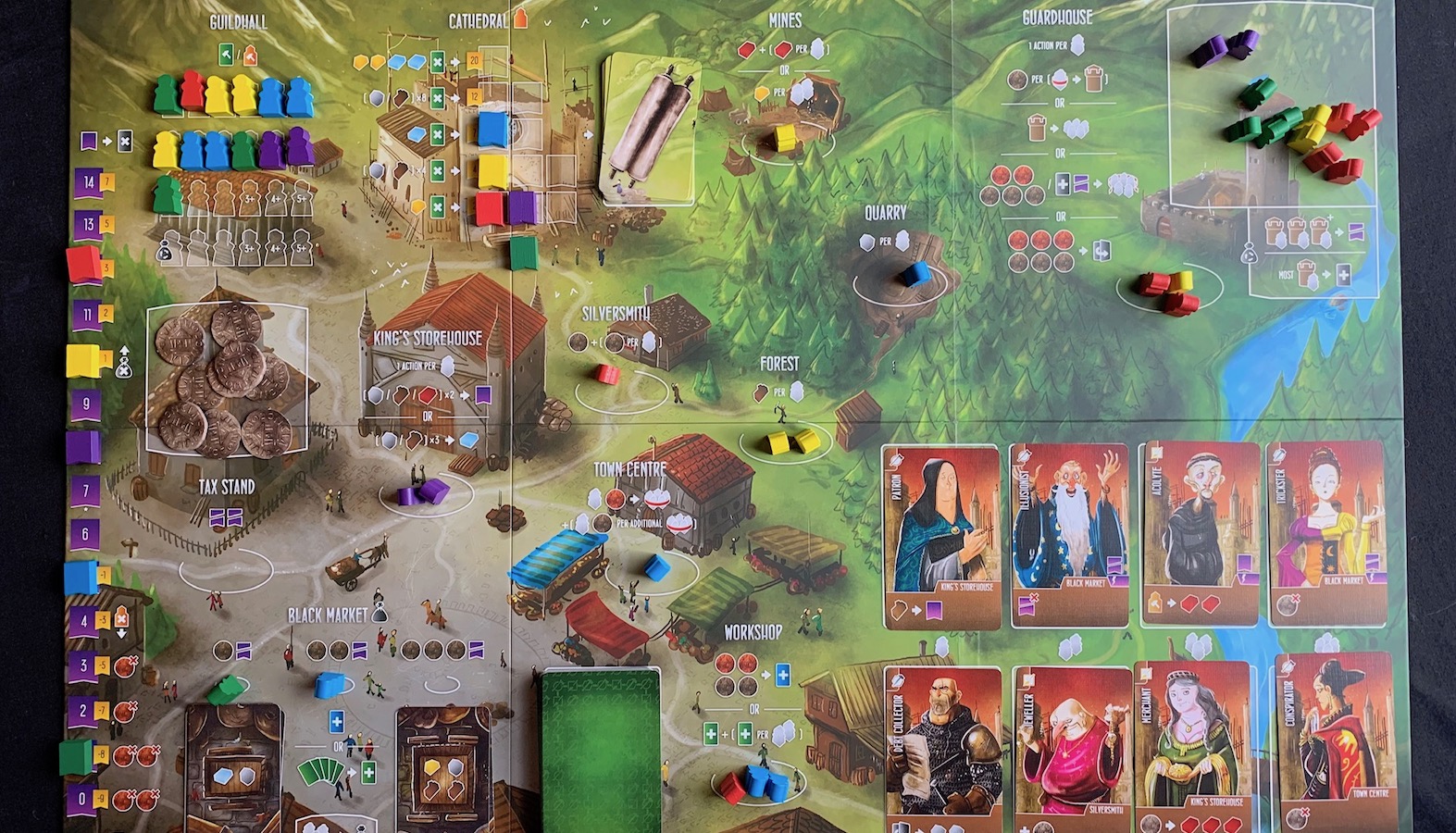
Players start with an unheard of 20 workers, and with the potential for unlimited placement in most spots, the game board fills up fast with players being able to take more and more powerful actions; so to slow your opponent down who is getting way too much out of their turn, one then has their worker visit the Town Centre. This mechanic is by far the most unique one of the game. It allows the player to gather opponents’ pieces from an area (or areas depending on how many workers committed to the action and player count) of their choosing. So when your opponent is getting way too good at mining gold you can pay a silver to send your worker out to capture their workers and place them on your player mat. Once they are there, you can choose in a future turn to send them to the Guardhouse, which is, for all intents and purposes, jail. For this action, you would get one silver coin for each of their workers you send there. To get them back, the opponent would then have to spend a turn to visit the Guardhouse and release them. Should you choose to not collect their bounty, but rather keep them on your mat to hinder the moves of your opponent, they could visit the Guardhouse and instead pay a whopping 5 coins or take a debt to take their workers back.
A few of the other spots such as the Workshop, Black Market, and Tax Stand offer you a unique opportunity to test your moral compass. Should you take the virtuous path, your virtue rises and is noted on the virtue track on the left of the board. The higher you go on it, the more end game victory points you earn, but good people don’t deal with shady characters, so you’ll lose the ability to access the Black Market. Go low on the virtue track, and you’ll lose end-game VP, but also start paying less for actions, as you start ignoring your taxes like the scandalous person you are. You’ll also lose the ability to help build the cathedral, which is the kind of selfless community-building project in which the most virtuous members of society are allowed to participate.
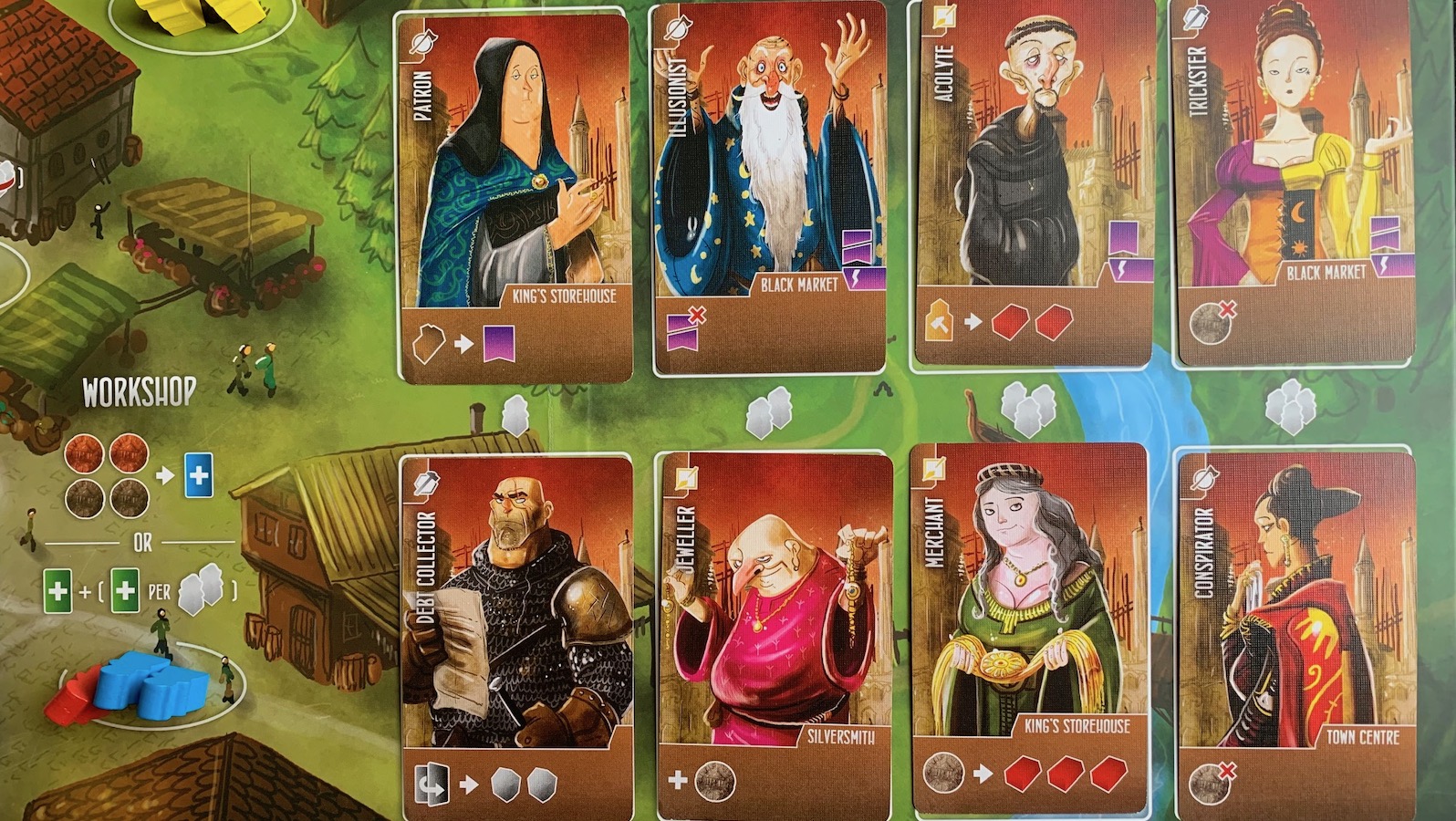
At the Workshop, you’ll hire apprentices to help you build your buildings or gain more building cards. Most of the apprentice cards have an icon at the top left corner showing what skill that apprentice specializes in. Carpentry, tiling, and masonry are the three skills you’ll see here and on many of the building cards. To construct a building, not only do you have to get the required resources to build, but you must have apprentices with the corresponding skill icons. These workers all have their special powers they bring to the table to make your game easier, and if you pair them well, certain actions will become a breeze for you. Many of these apprentices such as the Labourer, and the Woodcutter are honest workers and simply help you get your job done easier, getting you extra wood in the forest, or simply offering many skills that help you build. Should you choose to hire less reputable people though, they’ll help you in the game, but tarnish your reputation. The simple act of hiring the Swindler or the pickpocket immediately makes your marker take a step down on the virtue track, while hiring the virtuous Acolyte or Squire has the opposite effect. With one worker placed, players may hire from the first of four columns of workers, each with 2 cards in it. When they place more workers, they gain access to the other 3 columns, one at a time for each worker. Should the player want an apprentice card on an out of reach column sooner than that, they must pay coins for each column skipped, leaving it on the cards they skipped over. Anyone hiring the apprentices with these coins on them later gets to keep the coins as well as take the card.
The only spaces on the board set up more like a traditional worker placement game are the three in the black market. If a worker should choose to visit, they would pay 1,2, or 3 coins and go down in virtue for taking part in these illegal dealings. This area of the board is very profitable, giving you valuable/rare resources, workers, or building cards way quicker and easier than you can get them anywhere else, but it’s up to you to gauge whether the drop in virtue is worth it. Once the three spots here are full, everyone in them is swept away to jail and penalized depending on how many workers they have there. Do this too often and you’ll be riddled with debt, and end up having several of your precious VP taken from you at the game’s end. You can always buy back virtue at the King’s Storehouse, but that takes time and resources.
Many of these actions talked about here cost money, and the king takes his share of everything spent in the form of taxes. When there is a silver cost, any red coin icon in that payment indicates that you must pay that portion of the cost to the tax stand space on the board. For a free action, a worker can be sent to take all of the spent tax money as their own, but of course there is a hefty virtue fee to pay for this. Players should make sure the risk is worth it, but while they think about it the coins quickly pile up on the space, making it a very tempting move.
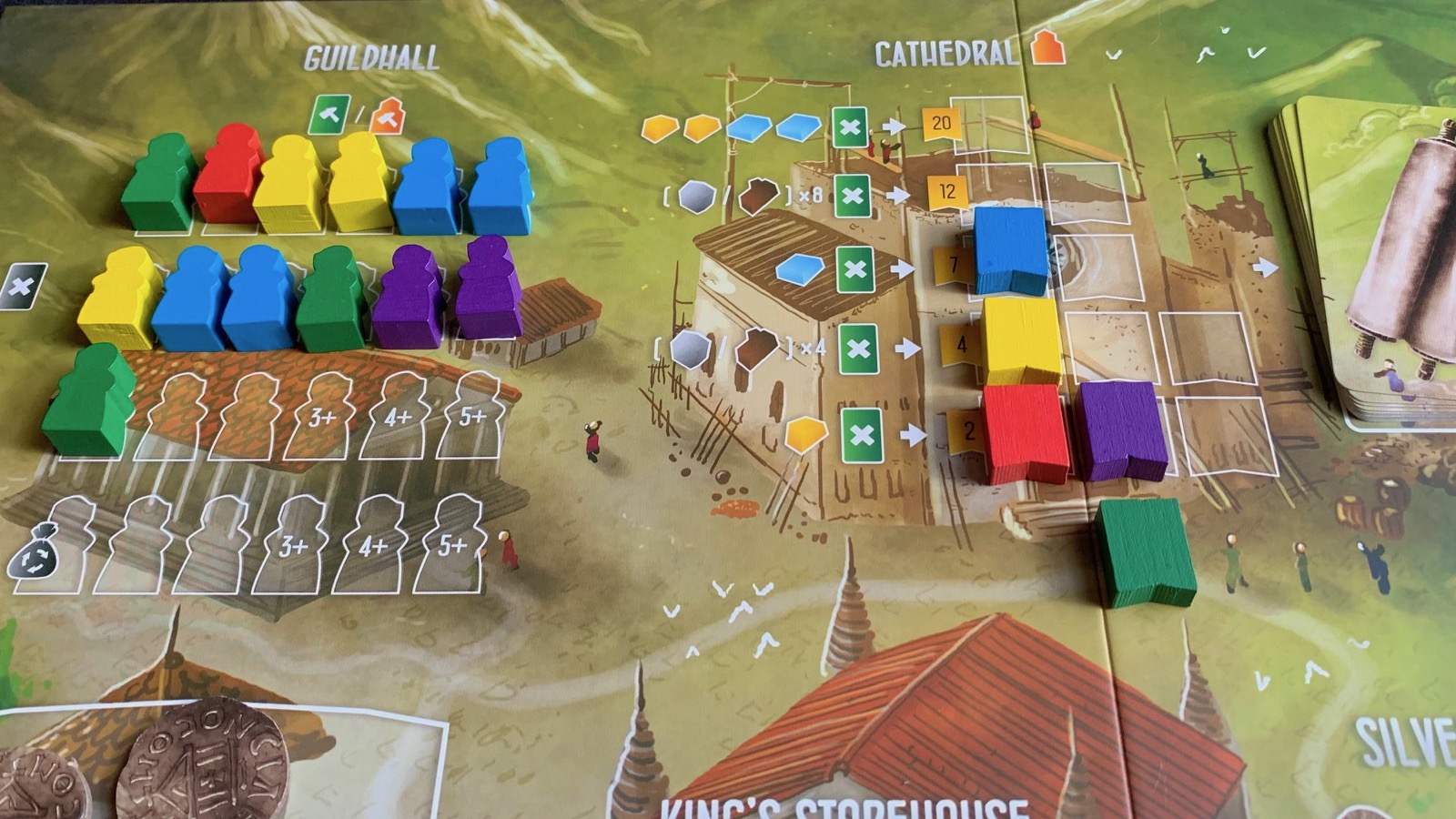
The last spot that needs mentioning is the Guildhall. This is the only spot on the map that your workers remain for the rest of the game once placed. Your two options here are to place a worker and build a building card from your hand or help build the cathedral. Both help you with your total VP score, but remember, only the virtuous can help with the cathedral. Anyone who does is immediately rewarded with precious resources and virtue. This action costs a building card discard and various resources depending on the level of the cathedral. The higher the level on the cathedral, the more VP one earns, and it escalates quickly. It should be noted, however, that there are only so many spots on each level, and only one on the final level, so the quickest acting will get the most points from this action and elbow out the competition. Regardless of the action taken at the Guildhall, the permanently placed worker works as a ticking clock. Once all of the spaces are taken here, the game ends, and everyone counts their points. So this is by far the biggest point grab, but the quicker this happens, the quicker the game is over. Players should do their best to keep track of how many points their opponents have before pushing this too far.
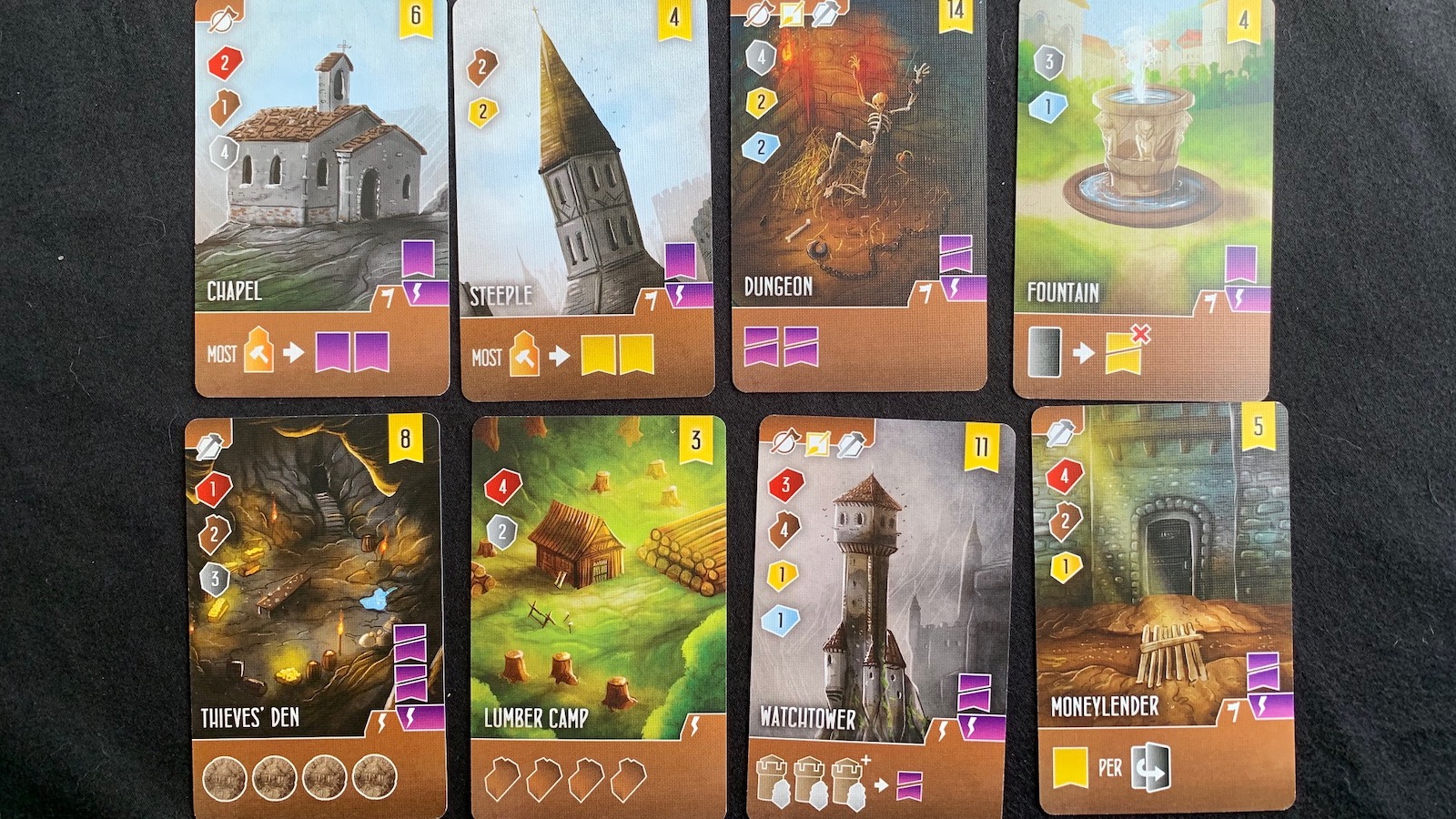
When Garphill published Raiders of the North Sea, they introduced a new way to play a worker placement with a, “leave a worker and take a different one back” mechanic. This, in my opinion, is one of the reasons it’s considered one of the best newer games in the genre. With Architects, they once again took a fresh look at how they could approach this idea differently, and once again it paid off. When you get your twenty workers it seems like too many at first, but if you aren’t careful, you’ll run out quickly. The fact that there is never a big sweeping action where all players take their workers back makes you have to make recovering your workers a big part of your strategy. If your opponent sees you getting a lot done in an area and decides to capture your workers, much of the time they won’t send them to jail but rather hold on to them to hinder your progress. If they have plenty of coins, there is no reason to give them all back to you for free. Players will find themselves having to use the capture action on themselves to reassign their workers. This move is slow and not ideal, but must be done if opponents play well as to force you into it. A very desperate player with no workers at all may spend their entire turn recovering just one worker from the board. This is truly a sign that you have painted yourself into a corner.
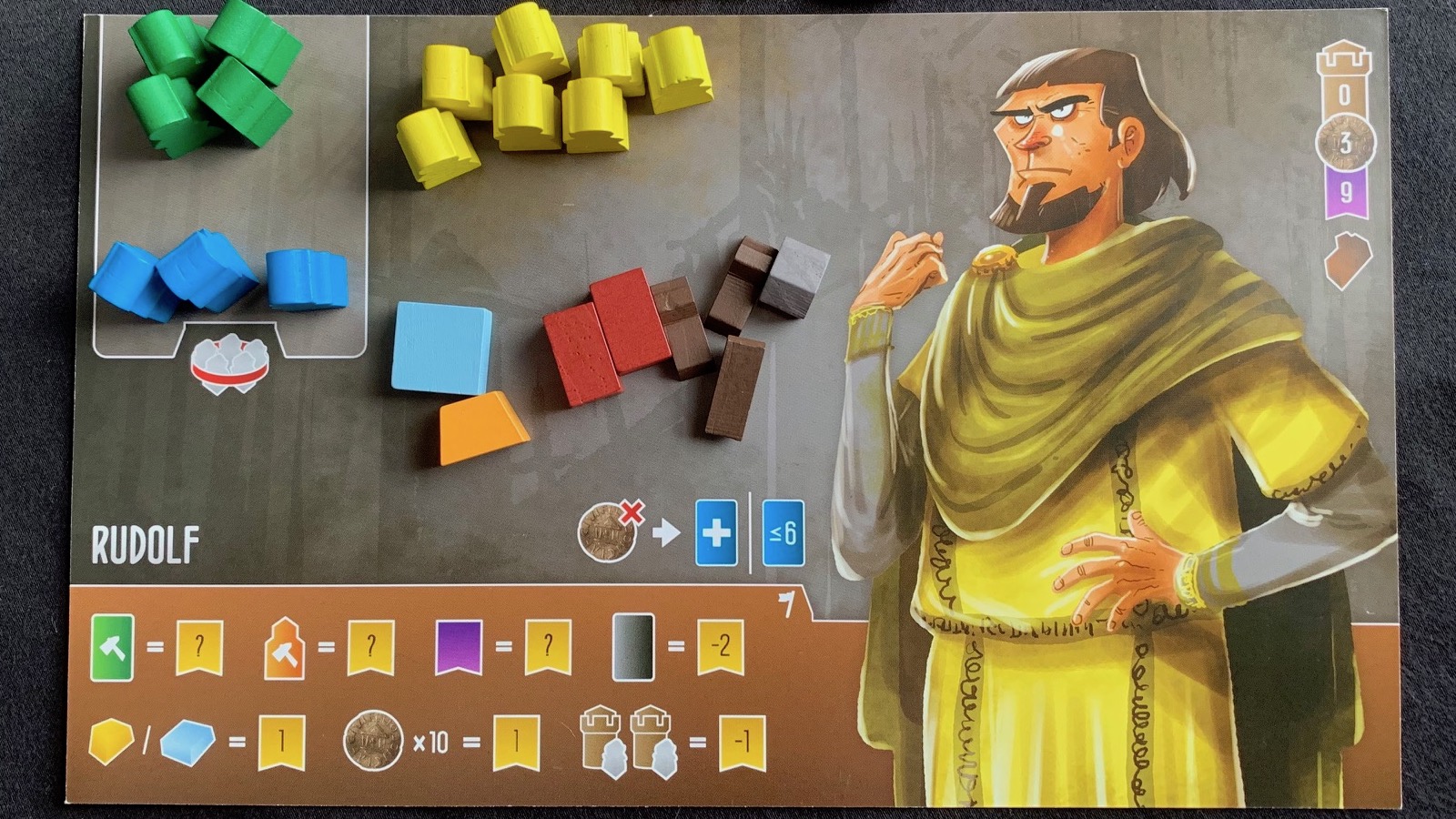
This game is beautiful and well thought out. I had a hard time coming up with negative comments about it. I played it with a friend that did NOT enjoy the “take that” aspect of the capturing element, and so I will say it may not be for all fans of worker placements. Games like Viticulture and Raiders offer a type of strategy that is clear and fun to plan, and not everyone will enjoy someone else grabbing their workers off the board in the middle of such a strategy. I will also say that Raiders of the North Sea brings such a great quality of components with it, that the thin flimsy player mats found in Architects leave a little to be desired in that respect. I do love, however, that the mats are double sided, one side where everyone has identical starting points and powers, another where each character starts with different strengths, weaknesses, and personalized abilities. This encourages players to use these strengths to help mold their strategy and makes the game more interesting as a whole. I’m assuming the cost of printing both of these sides is why we see less quality in the mats themselves compared to their previous titles.
The apprentice cards are a really great way to get what you need done put into action. When used well, these cards synergize with your plan of action and teamed with your growing number of workers on the board, can really accelerate your productivity. In just one of the plays, we encountered a set of cards that didn’t help us with this as much as we would have liked, but still had to purchase them for their building skills. This one time this part of the board didn’t seem ideal or exciting, but we haven’t encountered that again. Hopefully, we’ll never get this unfortunate combo in future plays, but it’s not wonderful that the potential exists.
I think most fans of Raiders will also really like Architects, and like me will look forward to see what else Garphill has in store for the West Kingdom when their next game Paladins of the West Kingdom gets released. I’ll be willing to bet we’re in for yet another delightful game.
Architects of the West Kingdom
Excellent
Architects of the West Kingdom is a great worker placement for fans of the genre that want to switch it up a bit with some fun original mechanics. Fans of Raiders of the North Sea will not be disappointed, unless they really dislike having other players mess with their progress.
Pros
- New take on a classic genre
- Symmetrical and asymmetrical character boards for varied difficulty keeps things unexpected and increases replay-ability
- Beautiful design with quality components…
Cons
- …except for the player mats that are flimsy and delicate
- “Take that” mechanic not for everyone
- Not all apprentice card combos make the workshop area a fun one to visit in the game
